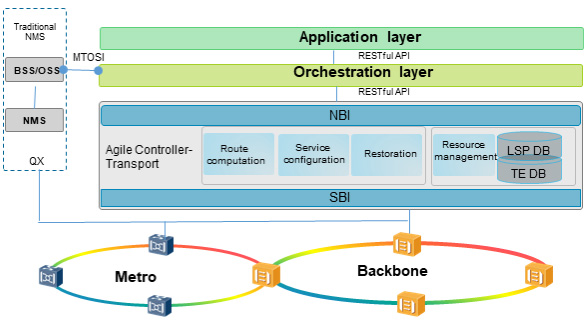Agile Controller-Transport
Huawei Agile Controller-Transport is the key TSDN component of the CloudOptiX solution intended for cloud-based transport network. It applies to diverse transport network scenarios such as the backbone, metro, and enterprise access network scenarios. The Agile Controller-Transport provides a variety of functions and features, such as real-time resource visualization and automatic network O&M. These functions and features make it addresses new requirements on innovation service experience and network flexibility and efficiency, proposed by the enterprise private line and DC interconnection.

Huawei Agile Controller-Transport uses a layered decoupling architecture to achieve component-based loose coupling. It uses Lego-style design for service modules to deliver on-demand service provisioning capabilities. It abstracts models by devices, networks, and services, and masks technical details. It simplifies the network model, provides intuitive and visualized views for users, communicates with WDM devices in real time, collects networking information, and offers functions such as centralized path computation and bandwidth on demand (BoD). With advanced algorithms, the Agile Controller-Transport implements automatic mapping from full types of services to L2/L1/L0, enabling fast provisioning of services at L2/L1/L0. In the northbound direction, it uses standard application programming interfaces (APIs) to support automatic invocation of upper-layer services and build a fast E2E service provisioning system.
Resource on Demand
The Agile Controller-Transport can provision bandwidth resources on demand, providing a new business model for private line operation and improving resource utilization and customer experience. With the dynamic and flexible bandwidth allocation policy of BoD, bandwidth sharing is performed in a staggered manner to fully share OTN line resources and improve line utilization. Tenants can provision and adjust private lines directly on an app. In addition, the function of one-click real-time bandwidth adjustment achieves instant bandwidth expansion for VIP customers based on their service requirements, flexibly meeting planned or burst traffic requirements and implementing the pay-as-grow business model. The Agile Controller-Transport can select the optimal path based on the minimum-latency policy for service provisioning, and enable private lines with guaranteed low latency. It can also compute and allocate existing network resources based on the OVPN link and bandwidth configurations, guaranteeing the operation of group customer services.
Resource Visualization
The Agile Controller-Transport can discover and visualize network resources at the service level, network level, and physical level on the entire network in intuitive manner. This allows users to quickly query and confirm idle resources on the entire network. It can also display network-wide resource utilization, helping expand link resources in advance if required and shortening the time to market.
- Service-level resource visualization: The Agile Controller-Transport can monitor service performance in multiple dimensions such as the latency, packet loss rate, jitter, and bandwidth utilization. It also clearly displays key data such as the contract fulfillment degree and generates KPI reports in real time, simplifying O&M.
- Network-level resource visualization: The Agile Controller-Transport can intuitively display the status of network-wide link resources and utilization statistics of wavelengths, sub-wavelengths, and ports. It can dynamically collect data on device link latency and warn users about network bottlenecks.
- Physical-level resource visualization: The Agile Controller-Transport shows all information about site subracks, slots, fiber cuts, and performance degradation, helping quickly locate fiber faults and ensuring the efficient operation of physical networks.
Automatic O&M
With the function of real-time network survivability analysis, the Agile Controller-Transport can analyze and predict service survivability and provide warnings about high-risk links during service provisioning, real-time monitoring, and fault simulation. This function ensures service reliability.
With the function of the maintenance window, the Agile Controller-Transport can perform in-service real-time fiber cut simulation to analyze service status (recovered or not). It also supports automatic one-click service migration and intuitively displays the migration process and results, improving the migration efficiency by several times.
Openness in the Northbound
The Agile Controller-Transport uses standard RESTful northbound interfaces and provides diverse northbound web-based APIs. Based on the northbound APIs and standard YANG model, the Agile Controller-Transport supports network service programmability and allows users or a third party to quickly develop various apps. This helps quick OSS integration and accelerates service innovation.
High Availability
The Agile Controller-Transport supports the active-standby mechanism that achieves high reliability and performance, improving product stability. It also supports the local hot standby mechanism to implement protection and enhance system reliability. In addition, it supports the remote cold standby mechanism. With this mechanism, service data can be restored as soon as possible when the local equipment room or server is faulty or powered off. Remote disaster recovery can be achieved to further enhance system reliability.
